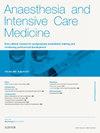区域麻醉治疗创伤急性疼痛
IF 0.3
Q4 ANESTHESIOLOGY
引用次数: 0
摘要
创伤是英国住院和入院的一个重要原因,包括不同的患者选择不同的镇痛需求和合并症的水平。最初的损伤和随后的治疗(如闭合复位和手术)引起的疼痛通常很严重,可能导致不适、护理物理治疗困难和不必要的入院。区域麻醉是为每位创伤患者提供个性化镇痛策略的完美选择,可以显著缓解疼痛,并减少对阿片类药物的依赖,阿片类药物具有显著的副作用,特别是在越来越多的老年创伤患者就诊时。这篇文章探讨了创伤区域麻醉的优点和缺点,并总结了具体的病人考虑的一些更常见的伤害,目前在英国的医院。我们也展望未来,随着更新的创新和新设备的使用越来越频繁,以及如何利用它们来造福创伤患者。本文章由计算机程序翻译,如有差异,请以英文原文为准。
Managing acute pain in trauma with regional anaesthesia
Trauma is a significant cause of hospital presentations and admissions in the UK, comprising a diverse selection of patients with differing analgesic needs and levels of comorbidity. Pain from the initial injury and subsequent treatments such as closed reductions and surgery is often severe and can lead to discomfort, difficulty in nursing care physiotherapy, and unwanted admissions. Regional anaesthesia is perfectly placed to provide an individualized analgesic strategy for each trauma patient that gives significant pain relief, and reduces reliance on opiate medications which have a significant side-effect profile especially in the increasingly elderly population presenting to hospitals with trauma. This article explores the advantages and drawbacks of regional anaesthesia in trauma, and summarizes the specific patient considerations in some of the more common injuries that present to hospitals in the UK. We also look to the future with newer innovations and novel devices coming into more frequent use and how they may be used to benefit the trauma patient.
求助全文
通过发布文献求助,成功后即可免费获取论文全文。
去求助
来源期刊

Anaesthesia and Intensive Care Medicine
ANESTHESIOLOGY-
CiteScore
0.50
自引率
0.00%
发文量
152
期刊介绍:
Anaesthesia and Intensive Care Medicine, an invaluable source of up-to-date information, with the curriculum of both the Primary and Final FRCA examinations covered over a three-year cycle. Published monthly this ever-updating text book will be an invaluable source for both trainee and experienced anaesthetists. The enthusiastic editorial board, under the guidance of two eminent and experienced series editors, ensures Anaesthesia and Intensive Care Medicine covers all the key topics in a comprehensive and authoritative manner. Articles now include learning objectives and eash issue features MCQs, facilitating self-directed learning and enabling readers at all levels to test their knowledge. Each issue is divided between basic scientific and clinical sections. The basic science articles include anatomy, physiology, pharmacology, physics and clinical measurement, while the clinical sections cover anaesthetic agents and techniques, assessment and perioperative management. Further sections cover audit, trials, statistics, ethical and legal medicine, and the management of acute and chronic pain.
 求助内容:
求助内容: 应助结果提醒方式:
应助结果提醒方式:


